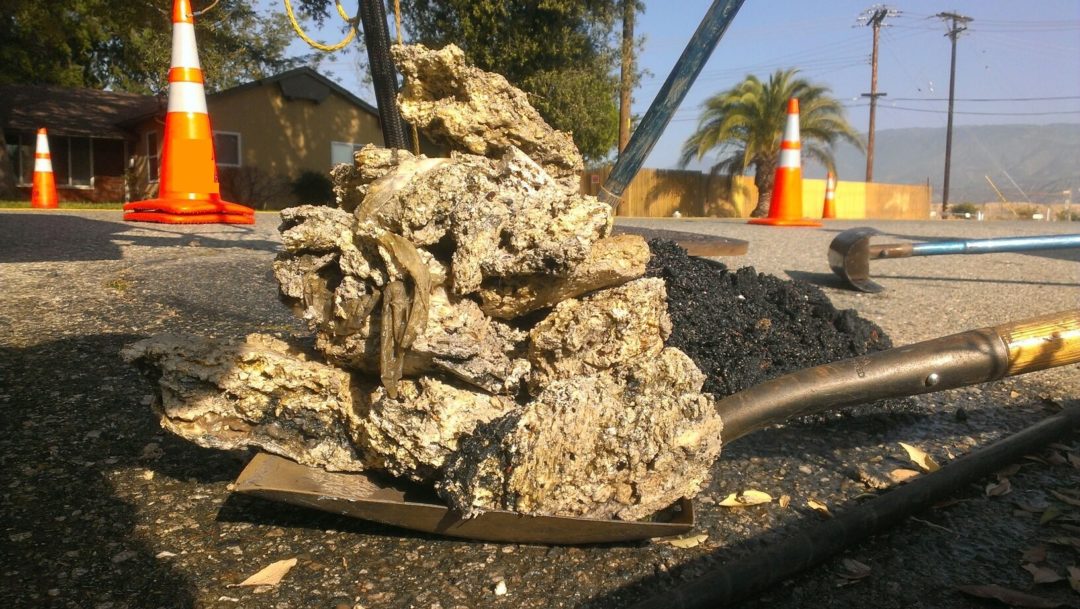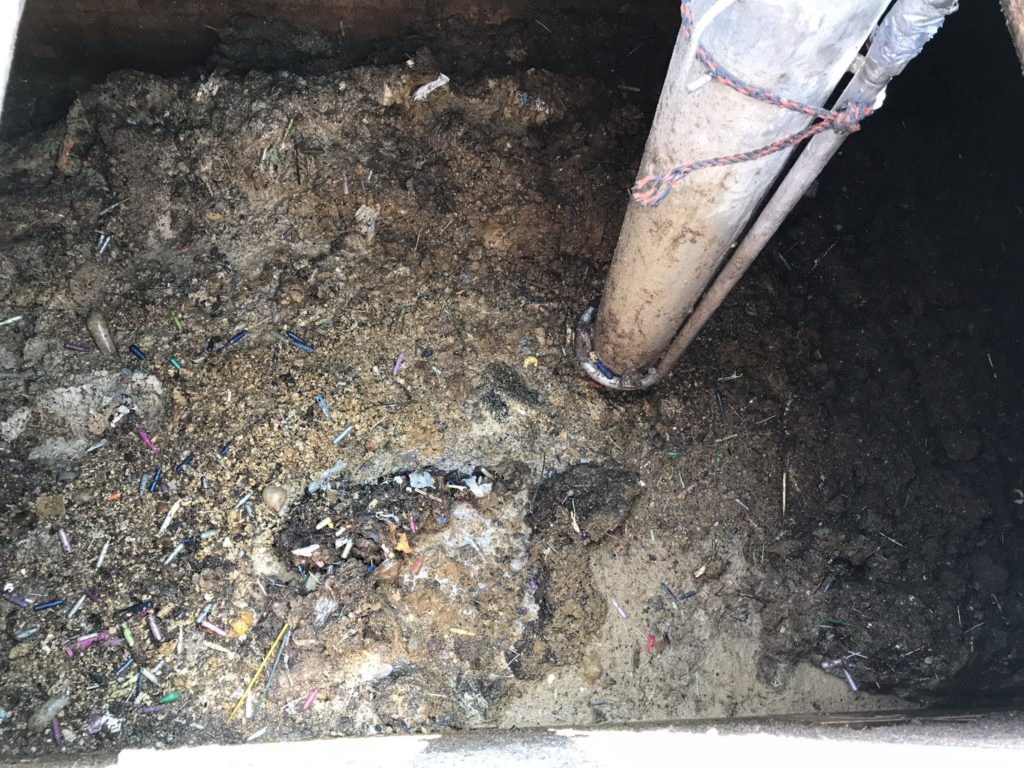Originally published on LinkedIn, reprinted here with permission…

Wipes (and some other junk) get flushed and then build up in our sewer systems. Wipes clog pipes.

Author Stephen N. Johns
Ahhh. That feeling that comes over you when you come home after a hard days work, plopping yourself onto that every so comfy couch that envelops all of your achy tired bones. Your twin toddlers come running out of the rear of the house, screaming with joy as they pounce on you with excitement. After playing with them for a few minutes, you instruct them to go back to what they were doing so you can enjoy the relaxation for a bit while greeted by your spouse. As your eyes close for a moment, enjoying the crisp air from the fan above you, you hear faint giggles and wonder what joyous event your kids are endeavoring in. Listening more intently, you hear “again, again” following by a whoosh sound and more giggles. But one doesn’t relax for too long as the calmness breaks from a frantic “uh, oh” and the sound of rushing water. After sprinting down the hall, you see your precious little angels next to the toilet, staring at you with wide eyes and colorless faces; toys swirling in the bowl in a slow, clockwise movement, as the water level barely recedes below the rim.
As a Collections System Maintenance Lead Worker, I have seen many items settled in the bellies of the intertwined underground network of sewer pipes across the City (I’ve met Splinter a few times but still have yet to shake hands with Donatello or his cohorts). If I kept all of the toys that have been retrieved from the wastewater collection system in the thirteen years that I have been with the City, kids and “adult,” and stacked them end-to-end, I could easily connect the goal posts on your favorite team’s football field. Add in all of the other nonbiodegradable items that have been too heavy to float down the river of excrement and a high probability exists that I could outline the shadow of One World Trade Center shortly after a cloud-free summer sunrise.
All of us (hopefully) have outgrown having GI Joe and Barbie go swimming in the porcelain bowl, but there are many items that we flush that wreak havoc on a building’s plumbing system and the municipal wastewater collection system. Feminine products commonly are wasted in the toilet versus deposited in a sanitary bin which is a big no-no. As these items are designed to absorb bodily fluids inside or snuggled against the body, they do a phenomenal job capturing liquid in the waste stream as they surf their way to the treatment plant. But sometimes these items get tired and grab the edge of a pipe to take a break, or the wave isn’t big enough to move them, so they get stacked up with their friends and eventually swell up not wanting anything else to beat them to the treatment plant finish line. Soon roaches that look like they could survive a nuclear winter come crawling out of the manhole covers in the streets, eventually being ground into the pavement by passing cars splashing through the sewage vomited through the manholes by the underground infrastructure. Before long, the nurse in the cottage up the street enjoying the shower after her graveyard shift at the local emergency room finds herself in a pool of rising blackwater with a stench so fierce it could peel the wainscotting off the walls. One of my coworkers or I receive the call, don our cape, and free the “white rat” blockage, returning the wastewater collection system to normalcy.
Now, now, tampons and pads aren’t the only items to blame. Remember the heavy nonbiodegradable products I told you about earlier? Those items create traffic jams in the sewers as well. Floatables, such as plastic applicators, cotton swabs, dental floss, candy bar wrappers, energy drink cans, and water bottles fly through the system like a full speed jet ski on a choppy river (those power flush toilets are uncannily amazing). And if those floatables arrive at a pump station holding tank, their trip through the collection system ends, and more of their floatable family members come to join them, trampling each other until eventually being smothered by more of their companions. The next time the floatables see daylight is when a fellow caped crusader opens the access cover to the pump station, witnessing a blanket of trash so thick floating on the water that its no wonder why the pumps failed and the neighborhood flooded overnight.
If it doesn’t have “toilet” in front of the word paper, it is not a paper product that you can flush. Tissue paper, cardboard applicators, paper towels and paper cores will not break down enough in the waste stream, potentially causing blockages in piping and pumps or affecting the biology at the wastewater treatment plant. “Flushable” cat litter clumps together when wet, like a rock, and based upon what I described above, what do rocks do and what do they cause?
And then we have the most egregious “flushable” item plaguing our industry today… the “flushable” wipe. Sure, a nice wet cloth feels better on my bum than a wadded up byproduct of a tree. But these things are eviler than the Grinch as they are nearly indestructible! Google “flushable wipes clog,” and you will find about 68,500 different links that you can read about to your heart’s content. Every collection system has experienced a system stoppage caused by these wipes that have become caught on pump housings, inlet screens, and rough pipe or manhole surfaces. According to the National Association of Clean Water Agencies, this problem is costing U.S. utilities up to $1 billion annually, costs that are passed on to ratepayers such as you and me.
The last critical item not to flush is an item that is not known for blockages at all. Unused medication, prescription and over-the-counter, is frequently deposited into the toilet. Almost all of it dissolves rapidly in the waste stream so why would it be a big deal? Medications can disrupt the biological processes occurring at wastewater treatment plants. Many of the medicines can’t be filtered out through treatment plant processes and are therefore discharged into local waterways, many of which are drinking water sources for other towns, and encountered in sludge used as crop fertilizer. Some aquatic life has shown high levels of estrogen and antidepressant medications within their tissues. So it doesn’t matter if you’re omnivorous, carnivorous or a herbivore if we keep flushing medicine down the water closet, our grandkids may end up birthing a Cyclops.

Whatever trash people flush we have to go and get it out of the sewer system. So please – don’t flush that trash!
Well, I think we’ve beaten the toilet with the plunger enough, let’s move on to the kitchen, the other fouler of waste plumbing. Most kitchen sinks have a garbage disposal that can be hungrier than a teenage boy with a hollow leg. But even though it can mash its teeth through almost anything you can feed it, it doesn’t mean you should do it. There are three questions you should ask yourself before you dump that product down the drain.
When the no-nos of the kitchen meetup with nonhuman waste discharged from the toilet, a synergistic game of Russian roulette is played in the wastewater collection system. It’s not a matter of if a blockage or system failure will occur, it is a matter of when and at what cost. One of the most massive blockages to date dubbed the “Whitechapel Fatberg” was found blocking a London sewer in September 2017, a mass the length of 22 double-decker buses weighing in at an estimated 130 tons.
While the toilet and the kitchen sink are the two primary recipients of problematic discharges, any other drain connected to your waste plumbing should not receive the items mentioned earlier. Other things not to be deposited down your drain are corrosive substances, flammable or explosive liquids, automotive fluids, paints, stains, wood preservatives, solvents, sealants, thinners and anything radioactive (sounds odd but is endemic with dialysis equipment). And let’s not leave out toxic or hazardous waste, fertilizer, herbicides, pesticides, insecticides, or any other ‘cides as well as anything that the hair on the back of your neck stands up and smacks you across the head telling you shouldn’t pour down. Not only can these items affect piping components in your building as well as the municipal system; they can also create hazardous environments for workers, putting their lives in jeopardy.
There are two acronyms that I hope you take away from reading this and introduce into your daily lives; one represents the do’s, and the other the don’ts. Every time you go to the bathroom, think of PPTP, as these are the only items you should flush: Pee, Poo, and Toilet Paper. And for those times spent in the kitchen, crafting that aromatic five-star cuisine or clearing the fridge from the two-week-old leftovers now turned science experiments, consider FOGG (Fats, Oils, Grease, and Grit) for items to avoid going down the drain. Following these two principals will give your plumbing a break, save your neighbors some headaches, and makes mine and my coworker’s job a lot easier as the drain is not a dump, and the toilet is not a trashcan!
What do you think about the wipes crisis in California’s sewer systems? Add your thoughts in the comments section below.
Learn more about wipes on CASA’s website at www.casaweb.org/wipes